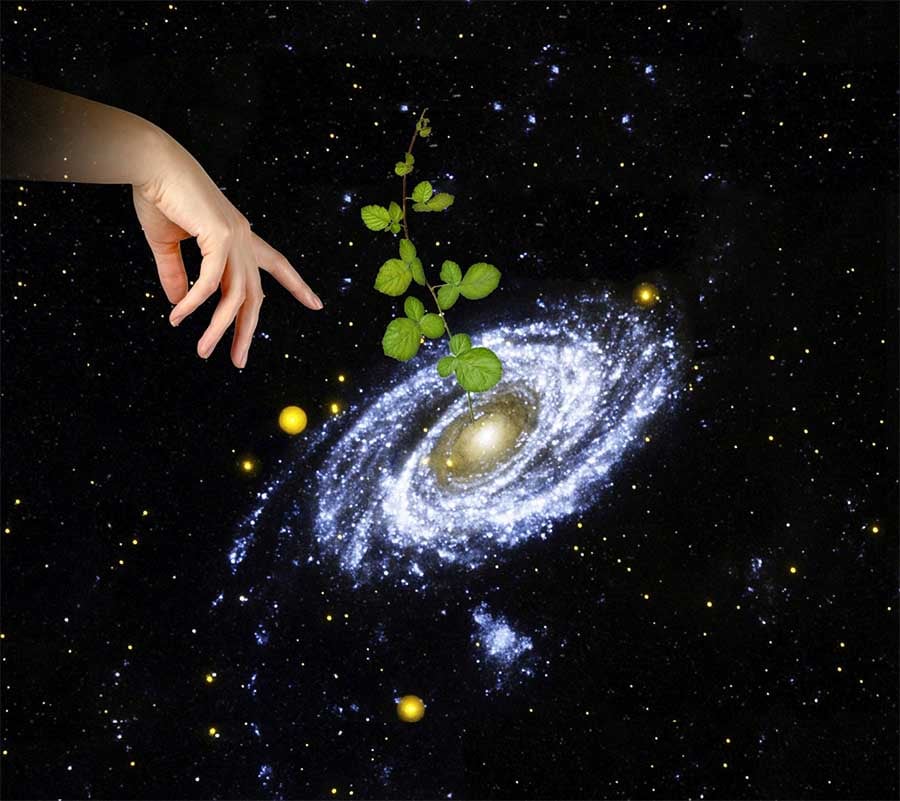Panspermia – The Idea That Life Came From The Stars
The astronomer Carl Sagan once said that the question of the nature of life on Earth and the question of whether life can be found beyond Earth are two sides of the same question. In the case of panspermia, both questions are succinctly answered. Life does exist beyond Earth and life as we know it on our green-blue planet came from outside of our atmosphere. Several celestial objects have been suggested as the source of life on earth by panspermia advocates. These include Mars, comets and asteroids, and even other star systems.
Early Ideas About Panspermia
Panspermia is a very old idea, going at least back to the ancient Greeks. Some of the first proponents of the scientific hypothesis in modern times include the astronomers Fred Hoyle and Chandra Wickramasinghe.
Although evidence has not been found for this origin-of-life hypothesis, discoveries have occurred in the past century which make panspermia more plausible. These discoveries include intriguing evidence that life may have once existed on Mars.
Another line of evidence that has given panspermia more credibility is the fact that the earliest indisputable evidence of life in the geologic record occurs around 3.8 billion years ago, near the end the Late Heavy Bombardment (LHB), a period of intense impact activity in the early solar system where the rate of collision between planetary bodies was much higher than it is today.
It is arguable that any life on Earth that existed on this planet before the LHB would have been wiped out, requiring an extraterrestrial origin for present life. This is just speculation of course, but it is made more plausible by the timeline of the emergence of life on Earth.
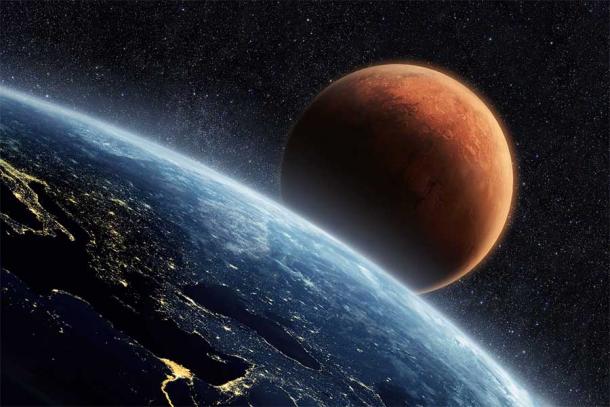
Earth in the foreground and Mars added behind. Many panspermia theories relate to Mars. (alonesdj / Adobe Stock)
Did Life on Earth Come from Mars?
In 1984, a meteorite was discovered in the Allan Hills region of Antarctica. It was simply labelled ALH84001, and it did not generate much interest for the next decade. In 1994, however, geochemical and microscopic analysis showed that the meteorite was a Martian meteorite and a very unusual Martian meteorite at that.
Scientists discovered that the meteorite contained complex organic molecules known as polycyclic aromatic hydrocarbons (PAHs), which are often associated with microbial activity. They also found magnetite mixed together with iron sulphide. These two minerals usually do not occur together in the presence of carbonates unless produced by life.
Furthermore, investigators found unusual looking rod-shaped nanostructures, which bore resemblance to certain types of bacteria. These three discoveries within the meteorite were taken by some scientists to be probable evidence of life on the red planet.

The ALH84001 meteorite from Mars, discovered in Antarctica, forced many scientists to take a closer look at panspermia views on the origins of life on earth. (NASA / Public domain)
The discoveries related to ALH84001 forced many scientists to take a closer look at the meteorite. Over the years, most of the evidence that originally seemed intriguing is now considered doubtful and a non-biological origin is currently favored.
PAHs can form readily in non-biological settings when organic molecules are subject to heating and the rod-like structures that resemble bacteria are probably too small to have ever been living things. The magnetite and iron sulphide, on the other hand, are still considered to be probable evidence for the presence of biology in ALH84001. Many of the magnetite grains are about the same size and shape as the grains produced by bacteria.
Furthermore, there is currently no known formation mechanism through which magnetite grains of that nature form in association with iron sulphide in the absence of biology.
The question of whether life exists or existed on Mars will ultimately need to be answered with a sample return mission, which is planned for the early 2030s. In the meantime, evidence continues to build that Mars was once a more clement and wetter planet that may have harbored life in the geologically distant past, though this is far from conclusive.
In addition to increasing the probability that life may have existed on Mars, the discovery of possible signs of life on Mars also has implications for whether life from Mars could have seeded life on Earth.
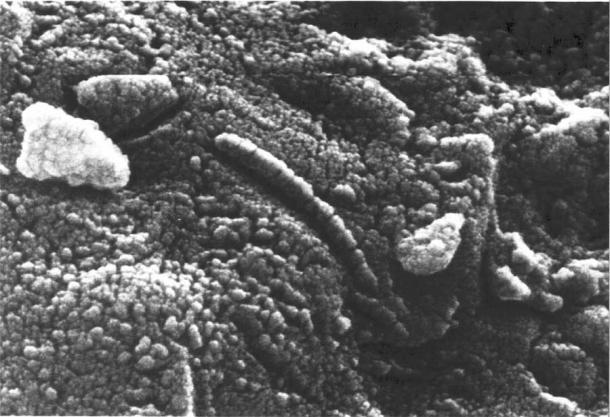
Electron microscopy revealed chain structures resembling living organisms in meteorite fragment ALH84001. (NASA / Public domain)
There are at least two major issues with the possibility of life on Mars seeding Earth. The first is whether life could have survived the journey. The second is whether there is a reason to believe that life would be more likely to have formed first on Mars rather than Earth. The answer to both questions, surprisingly, may be yes.
Even if microbes could survive the impact event and the extremes of the space environment, could they live long enough to make the journey since any trip from Earth to Mars could last for millions of years? Interestingly, bacterial spores recovered from extinct bees trapped in amber and brine inclusions in ancient salt crystals suggest that bacterial spores can last up to 250 million years and remain viable. Of course, amber or a brine inclusion in a terrestrial salt crystal are still mild environments compared to the interior of a collisional fragment from Mars drifting through interplanetary space.
There is also reason to believe that it might have been easier for life to form on Mars first rather than Earth. While life requires water, the formation of the building blocks of life are inhibited by the presence of water. In Earth’s early history, after it cooled, it was probably covered in a global ocean. Mars, on the other hand, went through periodic wet and dry periods during its early history.
A recent hypothesis for the origin of life is that life first formed in pools or shallow bodies of water that were regularly exposed to sunlight that periodically dried out. This would have resulted in the gradual build-up of organic compounds with each dry cycle, leading to the formation of layers of complex organics that could become the ingredients for life. The fact that Mars was probably not covered in a global ocean in its early history and had periodic wet and dry periods might have made early Mars an easier place for life to form than Earth. There is currently no indisputable evidence to suggest this, but there are reasons to believe that it is plausible. For all we know, we could all be Martians.
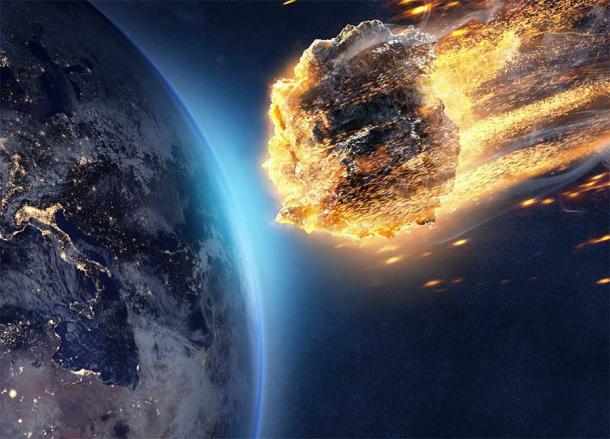
An asteroid flying towards earth. Some influential panspermia theories say meteorites could have brought life to earth. (lassedesignen / Adobe Stock)
Life From Comets or Asteroids?
Other popular targets for those interested in panspermia are comets and asteroids. Chandra Wickramasinghe, an astronomer and mathematician at the University of Buckingham, argues that life is likely to have formed in the interiors of comets. He furthermore has argued that the trillions of cometary objects that likely exist in the solar system provide many more opportunities for life to have formed than the environments of early Earth.
Alternatively, it is possible that a comet could have been infected with life by passing through the upper atmosphere of a life-rich planet. This could allow for life to implant itself on a comet without having formed on the comet. Of course, it does not explain how that life formed. It simply pushes the problem farther back in time and to a different planetary body.
On the other hand, if comets did contribute living material to Earth, they would also have contributed water. Although it has long been suggested that water on Earth was provided by comets, isotopic studies of comets in the past have shown that many of them have a different deuterium-hydrogen ratio than water found in Earth’s oceans.
This suggests that comets are not the primary source of Earth’s water and likely did not contribute other material either, including life. More recent studies of the deuterium-hydrogen ratio in comets show that some of them do have ratios consistent with those in Earth’s oceans. This suggests that comets could be the source of some of Earth’s water, and therefore life and organics, after all.
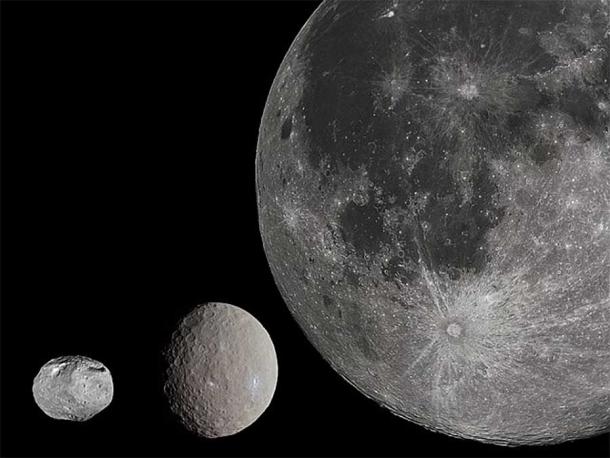
The largest asteroids recorded so far: Vesta (left), Ceres (center). The moon (right) has been added to provide a sense of scale. (Moon image: Gregory H. Revera; Ceres image: Justin Cowart; Vesta image: NASA/JPL-Caltech/UCAL/MPS/DLR/IDA / Public domain)
Another promising location for a non-planetary origin of life might be asteroids. Asteroids are rocky bodies that are mostly found between the orbits of Mars and Jupiter. Most asteroids are probably fragments of protoplanetary bodies that could have been the size of Vesta, about 530 kilometers (321 miles) in diameter. These primordial parent bodies of the asteroids were destroyed in catastrophic collisions in the early days of the solar system.
Much of what we know of the composition of asteroids comes from the study of meteorites, most of which are from asteroids. Studies of meteorites show that many asteroidal parent bodies were large enough and had enough radioactive isotopes in their interiors to go through either full differentiation or at least metamorphism. Many meteorites also show evidence of aqueous alteration in the interiors of their parent bodies, showing that they were heated enough for liquid water to be present.
Furthermore, many meteorites are rich in organics including amino acids. Many asteroidal and meteorite parent bodies may have had conditions in their interiors not very chemically different from the environments in which life is believed to have formed on Earth, and possibly Mars. Furthermore, isotopic analysis of asteroids shows that some asteroids have deuterium-hydrogen isotope ratios similar to water on Earth, making it more likely that asteroids contributed material to Earth during its formation.
The clear evidence of aqueous alteration, including the presence of clays and organics in asteroidal meteorites, makes impacting asteroids a probable source of life on Earth as far as the panspermia hypothesis is concerned. Asteroids may even be more promising sources of life than comets, many of which may never have been large enough to experience internal heating. Most comets that visit the inner solar system are only 1-10 kilometers (0.62-6.2 miles) across.
I should make it clear that this is merely speculation. So far, no evidence has been found which suggests that life came from asteroids or comets, but recent discoveries in asteroid science and the study of comets advance the viability of the panspermia hypothesis.

Another panspermia theory is that life could have come to earth from other star systems. (sakkmesterke / Adobe Stock)
Life From Other Star Systems?
Originally scientists were very doubtful that microbes within small rocks or dirt clods could survive the immense distances between the stars, especially since an interstellar trip would last hundreds of millions or billions of years. Furthermore, it was also thought unlikely that any objects from other stars systems would ever come close enough to a planet in an alien star system to collide with it.
This opinion has changed, somewhat, with the recent discovery of two interstellar bodies that have passed through our solar system in the last few years. The first was Oumuamua, the name of which means something like “first messenger from afar” in Hawaiian. It was discovered in 2017 by astronomers using a telescope operated by the University of Hawaii.
The second object was discovered in 2019. In addition to being given a more typical comet name, 2I/Borisov, the second interstellar object discovered is also a much more typical object, being indistinguishable from local solar system comets in all but its hyperbolic orbit.
In contrast, planetary scientists still debate over the nature of Oumuamua, explanations range from being the collisional fragment of an exo-Pluto to being an alien light sail, with the former hypothesis being the overwhelmingly preferred one in the planetary science community.
What is significant about 2I/Borisov and Oumuamua is that they were both interstellar objects and that they were both discovered only within two years of each other. This suggests that visitation by interstellar objects is more common than previously thought. This has led scientists to be more open to be possibility that life could travel not only between planets within a solar system but also between solar systems.
If life is not restricted only to one solar system until a technological species evolves capable of interstellar travel, then life might be a truly cosmic phenomenon. Interstellar space, rather than being dead, might in fact be brimming with life. This is of course speculation, and no evidence has been found so far to suggest that this is true, but recent scientific discoveries do make it more plausible.
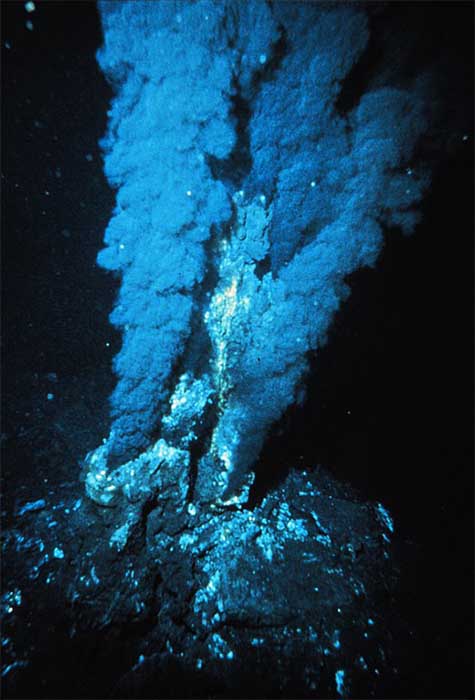
A bacterial black smoker at a mid-ocean ridge hydrothermal vent where the temperatures are extremely high. These rare deep-sea bacteria on Earth may also have originated elsewhere in our galaxy or another. (P. Rona / OAR/NURP; NOAA / Public domain)
Panspermia Moving Forward
Ever since panspermia was first proposed as a scientific hypothesis, it has been controversial and has often been associated with the fringe. Recent discoveries, however, seem to have redeemed the panspermia hypothesis, showing that there might be some truth to the idea.
- Upcoming UFO Report and its Implications for Human Origins Theory
- Anomalous Metallic Object Discovered Inside a 4.5 Billion-Year-Old Meteorite
There is currently no evidence that life formed on other planets. Nonetheless, with each astrobiologicaldiscovery, it becomes more likely that life will be discovered beyond Earth soon.
The question that could be asked is will this life be completely different from any life we have experienced, or will this life turn out to be our long lost interplanetary or interstellar cousins? The only way to find out is to keep exploring.
Top image: Panspermia theory argues that life came to Earth from elsewhere in our galaxy or even further away.Source: Dmitry / Adobe Stock
By Caleb Strom
References
Betz, Eric. 2020. Could Alien Life Travel on Interstellar Asteroids and Comets like 'Oumuamua? Discover Magazine. Available at: https://www.discovermagazine.com/the-sciences/could-alien-life-travel-on-interstellar-asteroids-and-comets-like-oumuamua
Bottke, W.F. ed., 2002. Asteroids III. University of Arizona Press.
Carr, M.H. and Head III, J.W., 2010. Geologic history of Mars. Earth and Planetary Science Letters.
“Case Study: Fossil Microbes on Mars?” n.d. American Museum of Natural History. Available at: https://www.amnh.org/learn-teach/curriculum-collections/cosmic-horizons-book/fossil-microbes-mars
Chapman, C.R., 1976. Asteroids as meteorite parent-bodies: The astronomical perspective. Geochimica et Cosmochimica Acta.
Choi, Charles Q. 2010. How Earth May Owe Its Life to Comets. Live Science. Available at:https://www.livescience.com/10229-earth-owe-life-comets.html
“Comets.” 2012. Lunar and Planetary Institute Explore. Available at: https://www.lpi.usra.edu/education/explore/comets/background/
Damer, B. and Deamer, D., 2020. The hot spring hypothesis for an origin of life. Astrobiology. Available at:https://www.liebertpub.com/doi/full/10.1089/ast.2019.2045
“Early Earth was covered in a global ocean and had no mountains.” 2017. New Scientist. Available at: https://www.newscientist.com/article/2130266-early-earth-was-covered-in-a-global-ocean-and-had-no-mountains/
Garvie, L.A. and Buseck, P.R., 2007. Prebiotic carbon in clays from Orgueil and Ivuna (CI), and Tagish Lake (C2 ungrouped) meteorites. Meteoritics & Planetary Science.
Guzik, P., Drahus, M., Rusek, K., Waniak, W., Cannizzaro, G. and Pastor-Marazuela, I., 2020. Initial characterization of interstellar comet 2I/Borisov. Nature Astronomy.
Hautaluoma, Grey, Alana Johnson, and Joshua Handal. 2020. NASA Moves Forward with Campaign to Return Mars Samples to Earth. NASA Press Release. Available at: https://www.nasa.gov/press-release/nasa-moves-forward-with-campaign-to-return-mars-samples-to-earth
Huss, G.R., Rubin, A.E. and Grossman, J.N., 2006. Thermal metamorphism in chondrites. Meteorites and the early solar system II.
Jackson, A.P. and Desch, S.J., 2021. 1I/‘Oumuamua as an N2 ice fragment of an exo‐Pluto surface: I. Size and Compositional Constraints. Journal of Geophysical Research: Planets.
Joshi, Sonali S. 2008. ORIGIN OF LIFE: THE PANSPERMIA THEORY. Helix. Available at: https://edubirdie.com/blog/origin-of-life-the-panspermia-theory
Lis, D.C., Bockelée-Morvan, D., Güsten, R., Biver, N., Stutzki, J., Delorme, Y., Durán, C., Wiesemeyer, H. and Okada, Y., 2019. Terrestrial deuterium-to-hydrogen ratio in water in hyperactive comets. Astronomy & Astrophysics. Available at: https://www.aanda.org/articles/aa/abs/2019/05/aa35554-19/aa35554-19.html
Loeb, A., 2021. Extraterrestrial: The First Sign of Intelligent Life Beyond Earth. Houghton Mifflin Harcourt.
Marshall, M., 2020. The water paradox and the origins of life. Nature. Available at: https://media.nature.com/original/magazine-assets/d41586-020-03461-4/d41586-020-03461-4.pdf
Martins, Z., Alexander, C.O.D., Orzechowska, G.E., Fogel, M.L. and Ehrenfreund, P., 2007. Indigenous amino acids in primitive CR meteorites. Meteoritics & Planetary Science.
McAdam, M.M., Sunshine, J.M., Howard, K.T. and McCoy, T.M., 2015. Aqueous alteration on asteroids: Linking the mineralogy and spectroscopy of CM and CI chondrites. Icarus.
McSween Jr, H.Y., Ghosh, A., Grimm, R.E., Wilson, L. and Young, E.D., 2002. Thermal evolution models of asteroids. Asteroids III, pg. 559.
Muir, Hazel. 2007. Did life begin on comets? New Scientist. Available at: https://www.newscientist.com/article/dn12506-did-life-begin-on-comets/
Mullen, Leslie. 2001. Carl Sagan. NASA Astrobiology Institute. Available at: https://solarsystem.nasa.gov/people/660/carl-sagan-1934-1996/
“Oumuamua.” 2019. NASA Science Solar System Exploration. Available at: https://solarsystem.nasa.gov/asteroids-comets-and-meteors/comets/oumuamua/in-depth/
“Prof Chandra Wickramasinghe.” n.d. University of Buckingham School of Computing. Available at: https://www.buckingham.ac.uk/directory/professor-chandra-wickramasinghe/
Shostak, Seth. 2018. Comets and asteroids may be spreading life across the galaxy. SETI Institute. Available at: https://www.seti.org/comets-and-asteroids-may-be-spreading-life-across-galaxy
Stierwalt, Sabrina. 2019. How Did Water Get on Earth? Scientific American. Available at: https://www.scientificamerican.com/article/how-did-water-get-on-earth/
“What is ALH 84001?” n.d. Lunar and Planetary Institute. Available at:https://www.lpi.usra.edu/lpi/meteorites/The_Meteorite.shtml
Wickramasinghe, C., 2010. The astrobiological case for our cosmic ancestry. International Journal of Astrobiology. Available at: http://adsabs.harvard.edu/full/2010IJAsB...9..119W
















